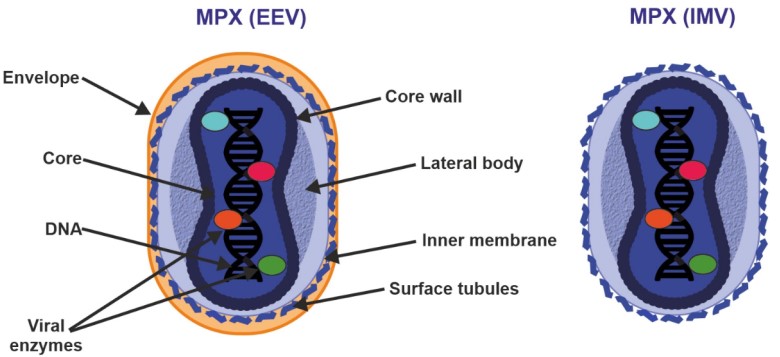Recombinant Monkeypox Virus A29L Protein [His]
Monkeypox Virus A29L protein, recombinant from E. coli
| Product Name | Cat. No. | Applications | Host Species | Datasheet | Price | Add to Basket |
|---|
| Product Name | Cat. No. | Applications | Host Species | Datasheet | Price | Add to Basket |
|---|
Monkeypox is a zoonotic disease caused by the monkeypox virus (Mpox), with clinical manifestations similar to smallpox but less lethal. Mpox belongs to the genus Orthopox in the family Poxviridae, and is the largest and most complex double-stranded DNA virus among viruses, with a brick or oval shape. The viral genome consists of double-stranded linear DNA with variable length inverted tandem repeat sequences (ITRS) at both ends, which form a hairpin structure at the end. ITRS accounts for approximately 3% of the genome sequence and is involved in the replication of the Mpox genome. Highly conserved genes related to key functions such as transcription and viral assembly are located in the central region, while the more mutated variable domains are located on both sides of the gene and are involved in virus-host interactions. Unlike most viruses, Mpox can only replicate within the cytoplasm of infected cells, and the proteins required for DNA replication, transcription, viral particle assembly, and release of Mpox are encoded by the viral central region of the genome, with a low degree of dependence on the DNA, RNA, and proteins of the host cell. The Mpox genome encodes about 200 proteins, some of which are involved in key steps of viral replication, ensuring that the virus itself can replicate successfully. Another part of the proteins is responsible for evading the host's immune response and achieving immune escape.
Mpox has two modes of infection, including intracellular mature virion (IMV) and extracellular enveloped virion (EEV), the latter of which is more infectious and can enter cells by fusing with the plasma membrane in a non-pH-dependent manner. The Mpox infection process consists of four stages: adsorption, fusion, replication and release of viral particles. EEV can bind and enter host cells through the interaction of viral surface proteins with glycosaminoglycans (GAG), the primary receptor on the cell membrane of host cells. The viral core is released into the cytoplasm after fusion of the virus and the cell membrane. The released Mpox genome is transcribed, replicated and translated and assembled to generate IMV.
 Figure 1. Structure of EEV and IMV
Figure 1. Structure of EEV and IMV
(Source: Kmiec D, et al. 2022)
The most common clinical feature of Mpox infection is a blister-like rash, with the onset beginning with a macular rash, then progressing to papules, blisters, pustules, crusting of mature lesions, and eventual drying and shedding. It also includes swollen lymph nodes, diarrhea and tonsillitis. Monkeypox is generally a self-limiting disease and most have a good prognosis, although symptoms may worsen in immunocompromised individuals. There are no specific drugs or vaccines for Mpox infection, and treatment is mainly supportive.
Mpox
MPXV
References
1. Kmiec D, et al. Monkeypox: A New Threat? Int J Mol Sci. 2022 Jul 17;23(14):7866.
2. Huang Y, et al. Monkeypox: epidemiology, pathogenesis, treatment and prevention. Signal Transduct Target Ther. 2022 Nov 2;7(1):373.
- Monkeypox Virus
- Monkeypox Virus (MPXV) Antigens
- Monkeypox Virus Vaccines
 Reagents for MPXV Assay Development
Reagents for MPXV Assay Development
Invoice / Purchase Order
Credit card
![]()




![Recombinant MPXV A29L Protein [His] (DAG-WT1016)](http://img2.creative-diagnostics.com/productimages-1/DAG-WT1016-1.jpg)
![Recombinant Monkeypox Virus M1R Protein [His] (DAG-WT758)](http://img2.creative-diagnostics.com/productimages-1/DAG-WT758-1.jpg)
![Recombinant Monkeypox Virus A35R Protein [His] (DAG-WT760)](http://img2.creative-diagnostics.com/productimages-1/DAG-WT760-1.jpg)
![Recombinant Monkeypox Virus B6R Protein [His] (DAG-WT773)](http://img2.creative-diagnostics.com/productimages-1/DAG-WT773-1.jpg)
![Recombinant Monkeypox Virus M1R Protein [His] (DAG-WT779)](http://img2.creative-diagnostics.com/productimages-1/DAG-WT779-1.jpg)